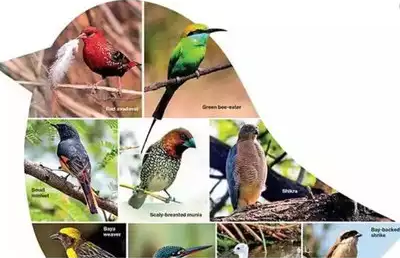WildLife Of India
The Magnificent Tapestry of Wildlife in India
India, with its vast and varied landscapes, stands as a testament to the incredible diversity of wildlife that inhabits its forests, plains, mountains, and coastal regions. The country's unique geography, climate, and ecosystems contribute to a rich tapestry of flora and fauna, making India one of the world's biodiversity hotspots. In this detailed exploration, we delve into the captivating world of Indian wildlife, from its iconic species to the challenges and conservation efforts that shape its future.
1. Biodiversity:
India's biodiversity is nothing short of extraordinary. The country is one of the 17 mega-diverse nations globally, hosting a staggering array of plant and animal species. This biodiversity is spread across various ecosystems, including tropical rainforests, deciduous forests, grasslands, deserts, and coastal areas. The Western Ghats and the Eastern Ghats, the Himalayan range, the Thar Desert, and the Sundarbans mangrove forest collectively contribute to India's ecological richness.To preserve this wealth of biodiversity, India has established a comprehensive network of protected areas, including national parks, wildlife sanctuaries, and biosphere reserves. These areas serve as crucial habitats for a myriad of species, providing a safe haven for both flora and fauna. Notable examples include Jim Corbett National Park, Kaziranga National Park, Sundarbans National Park, and Periyar National Park.2. Protected Area:
3. Iconic Species:
Among India's most iconic wildlife species is the Bengal tiger (Panthera tigris tigris), the national animal of the country. The Royal Bengal Tiger, known for its majestic appearance and strength, is found primarily in the Sundarbans and various tiger reserves across the country. Other flagship species include the Indian elephant, the one-horned Indian rhinoceros, the Asiatic lion, and the elusive Indian leopard.India is a paradise for bird watchers, boasting a bird population of over 1,300 species. The Himalayan region is home to stunning species like the Himalayan Monal and the Satyr Tragopan, while the Western Ghats harbor the endangered Great Indian Hornbill. Wetlands such as Bharatpur's Keoladeo National Park attract migratory birds like the Siberian crane, making India a crucial stop in their annual journey.
India's extensive coastline, stretching over 7,500 kilometers, harbors a diverse marine ecosystem. The Andaman and Nicobar Islands, with their pristine coral reefs, are home to a variety of marine life, including colorful fish, sharks, and rays. The Gulf of Mannar is another marine hotspot, known for its rich biodiversity and pearl oyster banks.
India has implemented several conservation projects to protect its endangered species. Project Tiger, launched in 1973, aims to conserve and increase the population of the Bengal tiger. Similarly, Project Elephant focuses on the conservation of elephants and their habitats. These initiatives have contributed significantly to the preservation of these iconic species, although challenges persist.
7. Conservation Challenges:
Despite conservation efforts, India faces numerous challenges in preserving its wildlife. Habitat loss due to deforestation, industrialization, and urbanization poses a significant threat. Poaching, driven by demand for wildlife products, remains a pressing issue, particularly for endangered species such as rhinoceros and tigers. Human-wildlife conflict, arising from the encroachment of human settlements into wildlife habitats, is another complex challenge.
Wildlife holds profound cultural significance in India. Many animals are revered in Hindu mythology, and some, like the elephant and the monkey, are considered sacred. Conservation efforts are often intertwined with cultural values, as communities recognize the importance of living in harmony with nature.
Tourism, when managed responsibly, can contribute to wildlife conservation. National parks and wildlife sanctuaries in India attract tourists from around the world, generating revenue that can be reinvested into conservation initiatives. Responsible tourism practices aim to minimize the ecological impact while providing educational opportunities for visitors.
In conclusion, India's wildlife is a marvel that reflects the country's natural splendor. The tapestry of life woven across its landscapes is a source of pride and responsibility. Through dedicated conservation efforts, responsible tourism, and a collective commitment to coexist with nature, India can continue to cherish and protect its extraordinary wildlife for generations to come.









Comments
Post a Comment